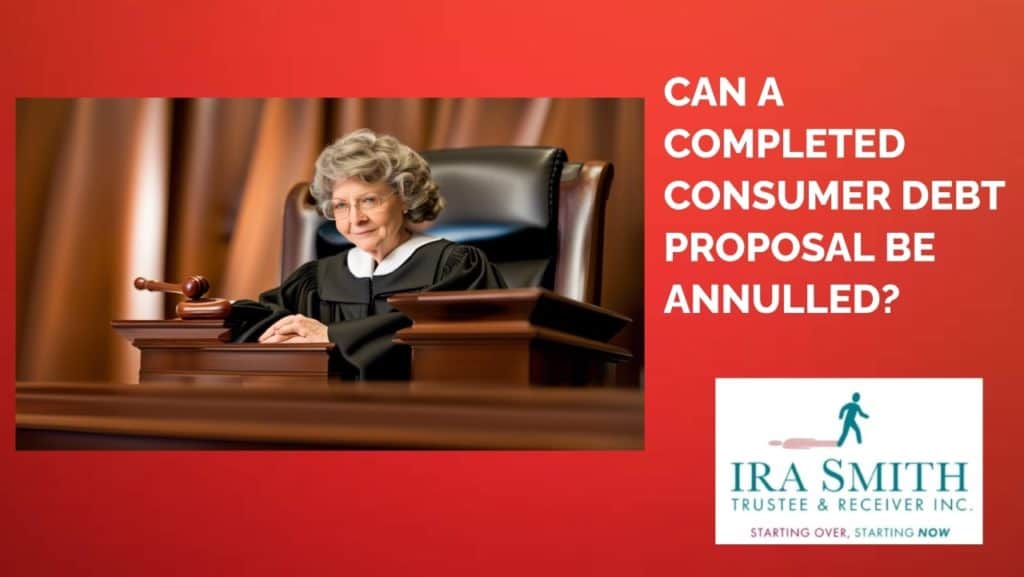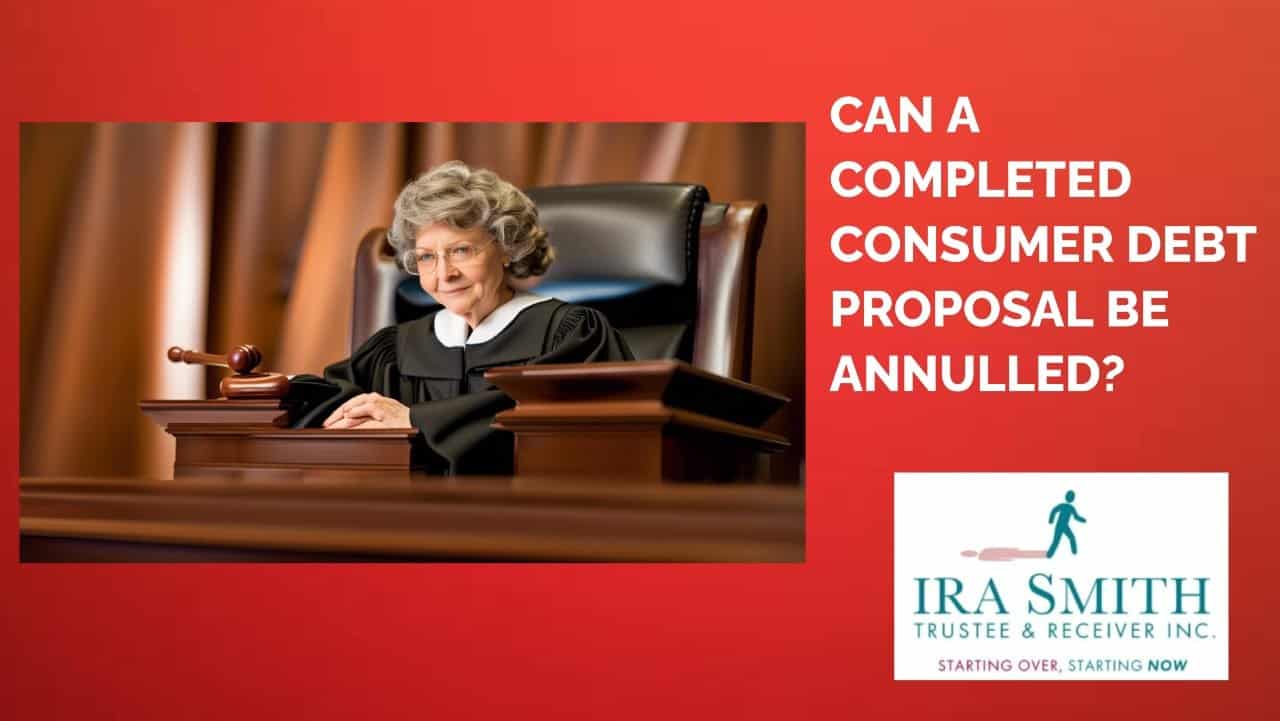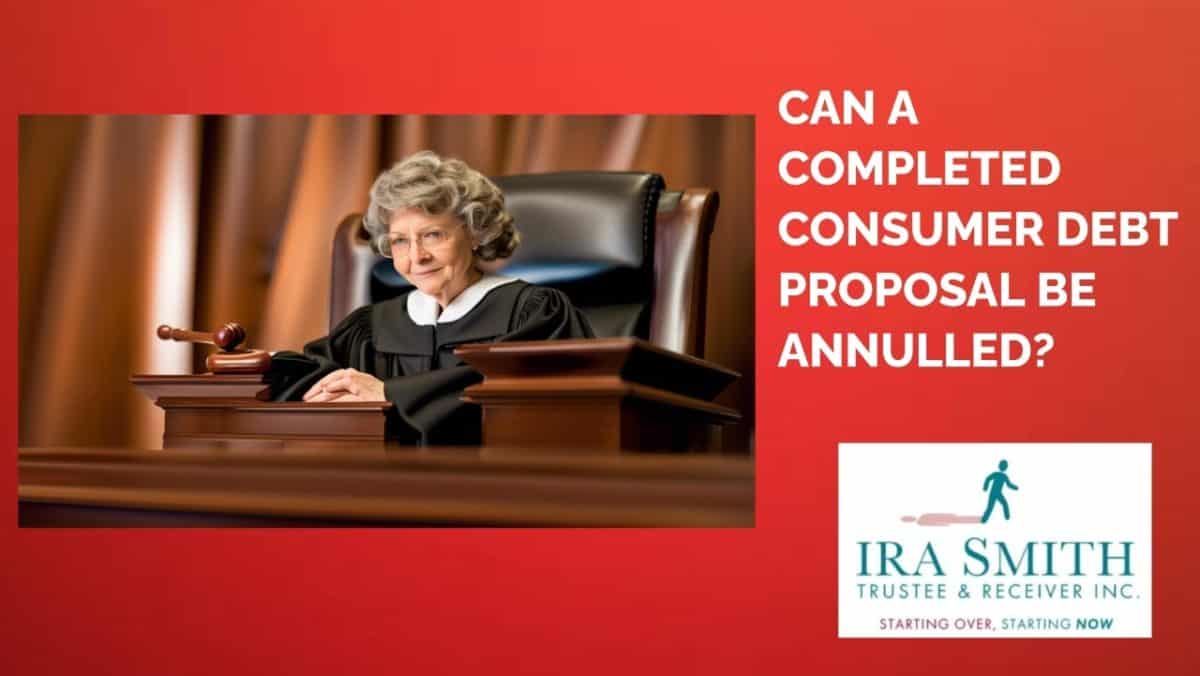Consumer Debt Proposal: Introduction
Welcome to Brandon’s Blog post where we will delve into the intriguing world of the consumer debt proposal and the legal framework surrounding them. Today, we will first look at what a consumer debt proposal is, why it is one of the most popular debt solutions to avoid personal bankruptcy and how to go about making one.
Then, we will take a close look at the case of Kamaljit Singh, shedding light on the authority and discretion of the courts when it comes to annulling a completed consumer proposal. Join us as we navigate the complexities of this case and gain a deeper understanding of the legal processes involved.
Consumer Debt Proposal: A Step-by-Step Guide to Financial Freedom
Dealing with debt can be overwhelming and stressful. However, there are solutions available to help manage and alleviate this burden. One such debt relief option is a consumer debt proposal, a formal agreement between you and your creditors to settle your debts for less than what you owe.
Here’s a step-by-step guide to creating a consumer debt proposal and taking control of your finances:
Assess Your Debt Situation:
Before creating a consumer debt proposal, it’s important to make a proper debt assessment. Calculate the total amount of debt you owe, including credit cards, loans, and other outstanding balances. Understanding the full scope of your debt will help you determine a realistic proposal that you can afford to pay. Any insolvent person who owes $250,000 or less (not including any debts secured by a charge on the personal residence) is eligible to make a consumer debt proposal to his or her creditors.
All types of debt qualify for this alternative to filing bankruptcy. Consumer debt, including income tax debts and if you are either a sole proprietor or partner in a business, business debts qualify for debt forgiveness.
Seek Professional Financial Advice:
Consult with a Licensed Insolvency Trustee or a non-profit credit counselling agency to discuss your options for managing your debt. They can provide valuable insights and guidance on creating a consumer debt proposal and negotiating with your creditors.
Create a Budget:
Develop a realistic budget that outlines your monthly income, expenses, and debt payments. This will help you determine how much you can afford to offer your creditors in a consumer debt proposal. Be honest and transparent about your financial situation to ensure the proposal is manageable for you.
Formalize the Consumer Debt Proposal Agreement With A Licensed Insolvency Trustee:
After the no-cost consultation, contact the Licensed Insolvency Trustee who will act as the Administrator in your consumer debt proposal. Provide the Licensed Insolvency Trustee with your list of assets, liabilities, income and expenses including the budget you prepared. The Licensed Insolvency Trustee will take this information and prepare all necessary filing documents, including, the consumer proposal. That is the formal legal agreement you the LIT will present to your creditors on your behalf to vote on.
Once you and your creditors have agreed on a consumer proposal, the Licensed Insolvency Trustee will obtain (deemed) court approval. The consumer proposal is a legally binding process after creditor acceptance and court approval. It outlines the terms of the proposal, including the total amount to be paid and payment terms, being regular monthly payments to your consumer proposal Administrator. It contains the repayment schedule and any other conditions agreed upon. Make sure to review this document carefully before signing it to begin your debt settlement program.
If both spouses are insolvent and the majority of the debts for each are the same, such as when one has co-signed for the other, then it is possible to eliminate these unsecured joint debts through a joint consumer proposal.
Negotiate the Consumer Debt Proposal with Creditors:
Once filed, the Licensed Insolvency Trustee will contact your creditors to advise of the consumer proposal. At this point, you have protection from creditors. All collection efforts, collection action and any legal action against you, including wage garnishment, must stop. The Administrator’s report will explain your financial hardship and offer a realistic monthly payment plan that you can afford.
If required, a meeting of creditors will be held where the Licensed Insolvency Trustee as Administrator will advise you on how to negotiate with creditors to reach a mutually beneficial agreement that will help you eliminate your debt in full by only paying a portion of it, while also satisfying creditor concerns.
The fee of the Administrator is paid out of the total amount to be paid in the consumer debt proposal. It is a Government tariff that the Licensed Insolvency Trustee is allowed to take out of your consumer proposal payments. Therefore, there is no additional cost to the insolvent debtor for professional fees of the Licensed Insolvency Trustee.
Although every situation is different, and there are no guarantees, a consumer proposal that offers to pay about 25% of the total outstanding unsecured debts, is the going rate for consumer proposals to be accepted by the unsecured creditors. This is what sophisticated unsecured creditors like chartered banks expect to see for them to vote for acceptance.
Adhere to the Consumer Debt Proposal Payment Plan:
A consumer debt proposal is a legally binding agreement. Stick to the consumer proposal terms of the repayment schedule outlined in the consumer proposal. Make timely monthly consumer proposal payments to your Administrator over the period of time called for (no greater than a maximum term time period of 60 months) to honour the agreement and gradually eliminate your outstanding debt. Stay committed to your financial goals and prioritize debt repayment to achieve financial freedom.
If you are lucky enough to have a family member willing to lend you the total amount of your consumer proposal, this enhances the chances of a successful consumer debt proposal. It is an effective tool as creditors always look kindly on an immediate lump-sum payment, rather than having to wait up to 5 years to see their reduced amount of money.
Monitor Your Progress:
Track your progress and monitor your debt repayment journey as you make your payments on time. Celebrate each milestone as you eliminate your unsecured debts and work towards financial stability. Examples of unsecured debts that are eligible debts to be eliminated in a consumer proposal are:
- unsecured lines of credit;
- credit card debt;
- personal loans;
- vehicle loans;
- personal income taxes; and
- other unsecured loans;
Stay motivated and focused on your financial goals to successfully manage your consumer debt.
By following these steps and creating a consumer debt proposal, you can take control of your finances and work towards a debt-free future. Remember, seeking professional guidance and staying committed to your repayment plan are key components of a successful debt management strategy.
Can A Consumer debt proposal Be Annulled? Exploring the Case of Kamaljit Singh
In the matter of the consumer proposal of Kamaljit Singh, an important question arises: Does the court have the authority under the Bankruptcy and Insolvency Act Canada (BIA) to annul a consumer proposal that has been approved by creditors and fully performed by the consumer debtor, even after the administrator has been discharged? This question, along with the subsequent determination of whether the court should exercise its discretion to grant the requested annulment, forms the crux of the case.
The first issue at hand is the authority of the court to annul a completed consumer debt proposal. According to subsection 66.3(1) of the BIA, the court does indeed possess the statutory authority to annul a fully completed consumer proposal. This crucial section allows for the annulment of a consumer proposal in cases of:
- default
- ineligibility of the debtor
- injustice
- undue delay or
- if the court approval was obtained by fraud.
By analyzing this section in the context of the case of Kamaljit Singh, we gain insights into the court’s decision-making process.
Furthermore, it is essential to explore the factors that the court considers when exercising its discretion to annul a consumer debt proposal. In the case of Kamaljit Singh, several factors played a role in the court’s decision.
The knowledge of the debtor and their obligation to disclose potential claims, the creditor’s knowledge of all factors in considering the consumer proposal, the eligibility of the consumer debtor to file a consumer proposal, the amount and nature of the debt, the timing of the application, the interests of the debtor and creditors, and the integrity and public confidence in the bankruptcy system all weighed heavily in the court’s deliberations.
Background – Consumer Debt Proposal Proceeding
Mr. Singh’s statement of affairs dated September 16, 2019, listed unsecured liabilities totalling $81,555, and a contingent amount of $60,000 for the Canada Revenue Agency (CRA). An unsecured creditor, Mr. Nagra, claimed that $ 94,027.98 was owed to him under a judgment as of the date the consumer proposal was filed.
Mr. Singh states that he was not aware of the existence of the default judgment when he had discussions with the licensed insolvency trustee acting as the consumer debt proposal Administrator before filing his consumer proposal, or at the meeting of creditors. The Administrator’s report dated September 18, 2019, refers to an estimated total amount of claims of $81,555. The report also indicates that Mr. Singh’s interest in his matrimonial home was between $30,222 and $75,222 and that Mr. Singh was unable to sell or refinance the property at that time.
The minutes from the creditors meeting held on December 11, 2019 show that there was a total of $136,833.54 in voted claims, which included $75,596.40 for CRA. CRA was the sole creditor that voted in favour of the consumer proposal. The other six proven creditors voted against the consumer proposal. The Dividend Sheet prepared by the Administrator, with a declaration date of March 9, 2023, shows:
- $162,326.40 in proven claims; and
- $35,373.23 in dividends being paid to the creditors.
Based on a comparison of the statement of affairs and Dividend Sheet, the change from claims totaling $81,555 to $162,326.40 was due to:
CRA having proven a claim of $73,770.60; and
the proven claims of the remaining nine creditors being in aggregate, $7,000.80 higher than the amounts listed in the statement of affairs.
Consumer Debt Proposal: Factors to Consider When Exercising Discretion under Subsection 66.3(1)
The authority to annul a proposal is discretionary. In exercising such discretion, the Court should take into account the interests of the debtor and his or her creditors and balance their interests while maintaining the integrity and confidence of the public. Based on the Court’s review of applicable cases, the Court concluded that the following factors must be taken into consideration:
- knowledge of the debtor;
- the creditors’ knowledge of the consumer debt proposal;
- eligibility of the consumer debtor to file a consumer proposal;
- amount and nature of the debt;
- timing of the application;
- the interest of the debtor and creditors; and
- the integrity and public confidence in the BIA and the process of consumer proposals.
Test for Annulment of a Consumer Debt Proposal
The test for the annulment of a consumer proposal is set out in subsection 66.3(1), which provides that:
Where default is made in the performance of any provision in a consumer proposal, or where it appears to the court:
(a) that the debtor was not eligible to make a consumer proposal when the consumer proposal was filed,
(b) that the consumer proposal cannot continue without injustice or undue delay, or
(c) that the approval of the court was obtained by fraud,
the court may, on application, with such notice as the court may direct to the consumer debtor and, if applicable, to the administrator and the creditors, annul the consumer debt proposal.
Subsection 66.3(1) does not contain language that restricts the timing when such an application for an annulment of a consumer proposal may be made.
This differs from the language of subsection 66.3(3), which provides that a consumer proposal may be annulled after it is“accepted or approved” where the consumer debtor is afterwards convicted of any offence under the BIA.
Consumer Debt Proposal: Knowledge of the Debtor
Mr. Singh was personally served with the statement of claim. He did not take any steps to defend that claim. Mr. Singh states that even if he had been aware of the existence of the default judgment and the writ, he would not have disclosed them to the Administrator because he did not believe that he owed any amount to Mr. Nagra given the payments he and his mother had made to him.
While Mr. Singh may not have had actual knowledge of the default judgment and the registration of the writ at the time he initially met with the Administrator, he was required under the BIA to provide them with information on his financial situation. It was his obligation to inform the Administrator of any potential claims against him, even those he may dispute. The BIA consumer debt proposal process must have at its foundation that all properly secured debts and unsecured debts and liabilities will be disclosed by debtors seeking the protection of the Act.
It was open to Mr. Singh to take the position with the Administrator that Mr. Nagra’s claim should be listed as a contingent amount. This was how the claim of CRA was treated in the statement of affairs. Mr. Singh suggests that he relied on the Administrator to have performed due diligence in connection with filing his consumer proposal and that they did not discover the existence of the default judgment or the writ.
The Administrator is required to investigate or cause to be investigated, the consumer debtor’s property and financial affairs to be able to assess with reasonable accuracy the consumer debtor’s financial situation and the cause of his insolvency. Whatever the steps taken by the Administrator to investigate Mr. Singh’s affairs are, it did not absolve Mr. Singh from the requirement to notify the Administrator of the fact that he had been served with a statement of claim in the previous six months.
Therefore the Court’s view of the knowledge of the debtor that a claim was being pursued by Mr. Nagra, and his failure to disclose this to the Administrator at any time during the consumer debt proposal proceeding, weighs in favour of annulling the consumer proposal.
Consumer Debt Proposal: Knowledge of the Creditor
Mr. Nagra stated that he first learned about the consumer proposal proceeding on June 9, 2023, based on correspondence received by his counsel from counsel to Mr. Singh. He says that had he been notified of the consumer proposal, he would have participated in the process and opposed the proposal. Mr. Singh claims that Mr. Nagra had been aware of the consumer debt proposal since 2019, but he provided no evidence in support of this statement.
Based on the evidence, the Court accepted Mr. Nagra’s evidence that he did not become aware of the consumer proposal until June 9, 2023, which was after the consumer proposal had been completed and the Administrator had been discharged.
Eligibility to File a Consumer Debt Proposal
At the time of the completion of the consumer debt proposal, there was $162,326.40 in proven claims, which, together with his claim of $94,027.98, exceeds the $250,000 consumer proposal threshold. Mr. Singh contests the amount he is said to owe to Mr. Nagra. However, Mr. Nagra has a judgment against Mr. Singh, and that judgment had not been set aside.
An Administrator cannot file a consumer proposal if he or she has reason to believe that the consumer debtor is not eligible to make a consumer proposal. As of September 16, 2019, if Mr.Nagra’s claim of $94,027.98 had been added to the $81,555 listed in the statement of affairs, along with the $60,000 contingent amount for the CRA, the total amount of claims would have been $235,582.98.
By the December 11, 2019 creditors meeting, CRA had a proven claim of $75,596.40, so the total amount of claims would have increased to $251,179.38. As a result, Mr. Singh would no longer have been eligible to complete a consumer debt proposal by the time of the creditors meeting if Mr. Nagra’s judgment was known to the Administrator.
A consumer proposal is not invalid by reason only that the debtor was not eligible to make the consumer proposal. If an Administrator determines, after the filing of a consumer proposal, that it should not have been filed because the consumer debtor was not eligible to make a consumer proposal, all that is required of the Administrator is that he or she shall forthwith inform the creditors of this fact. It is on the creditors to commence an application to annul the consumer proposal.
Consumer Debt Proposal: Amount and Nature of the Debt
While the amount is disputed by Mr. Singh, Mr. Nagra has a judgment for $94,027.98. That represents approximately 36.68% of the total claims proven against Mr. Singh. It is a significant claim. The nature of the claim must also be taken into account. As acknowledged by Mr. Nagra in his materials, as he is Mr.Singh’s father-in-law, they are connected by marriage and he and Mr. Singh are deemed to be related persons under the BIA.
Subsection 66.19(2) provides that a creditor who is related to the consumer debtor may vote against but not for the acceptance of the consumer debt proposal. Based on what happened at the meeting of creditors, where $75,596.40 of claims voted in favour of the consumer proposal, and $61,237.14 voted against it, had Mr.Nagra been able to file a proof of claim in an amount over $14,400 and voted against the consumer proposal, it would have failed.
Consumer Debt Proposal: Timing of the Application to Annul
There is no issue with the timing of Mr. Nagra’s motion to annul the consumer debt proposal. He learned of it on June 9, 2023, and submitted a request to the BankruptcyCourt Office to schedule the motion on July 13, 2023.
Consumer Debt Proposal: The Interest of the Debtor and the Creditors
As noted above, Mr. Singh’s proven creditors received $35,373.23 in dividends on account of $162,326.40 in claims. This amounts to a recovery of 21.79 cents on the dollar. If the proposal is annulled, these creditors, along with Mr. Nagra, will be permitted to take steps to recover additional amounts, which would include the $103,631.63 from the sale of the matrimonial home. Unsurprisingly, it would be to Mr. Singh’s detriment if the consumer debt proposal is annulled, since his creditors’ claims would be revived, and they could take steps to recover the $ 103,631.63 that he currently is entitled to keep.
The Court decided that, in balancing the interests between Mr. Singh and his creditors, it weighed in favour of the creditors to annul the proposal. If the consumer proposal is not annulled, Mr. Singh will be permitted to only pay $35,373.23 in dividends to his creditors and keep $103,631.63, because he did not inform the Administrator of the existence of Mr. Nagra’s claim. The Court believed that this would be an unfair result, and negatively impact the integrity of the consumer proposal process under the BIA.
Integrity and public confidence in the BIA and the process of a consumer debt proposal
Mr. Singh argued that the public confidence in the BIA and the process of a consumer debt proposal would be lost if “innocent debtors” like him could have their consumer proposals annulled. The Court felt that Mr. Singh was not “innocent” and that the integrity of the system would be undermined if a debtor was permitted to benefit from not disclosing a potential claim to his or her Administrator at the commencement of the process.
This is especially so in this case because, if the debt to Mr. Nagra was disclosed, it could have a material impact on whether a consumer proposal would be accepted by creditors. The system requires that creditors have confidence that they will be provided with proper notice of a consumer proposal and have the ability to elect to participate in the process if they so choose.
The Court’s Disposition of this Consumer Debt Proposal Matter
The Court has the discretion to annul a consumer debt proposal under subsection 66.3(1), even where the consumer proposal was fully completed. Having considered all of the circumstances and factors listed above, Mr. Nagra satisfied the Court that his motion fits under subsection 66.3(1)(a) and that this is an appropriate case in which to exercise the Court’s discretion.
Therefore, the Court annulled Mr. Singh’s consumer proposal even though he completed it and the Administrator was discharged.
Consumer Debt Proposal: Closing Remarks
The case of Kamaljit Singh serves as a fascinating example of the authority and discretion of the courts in annulling a completed consumer proposal. By carefully considering the factors and legal principles at play, the Court ultimately decided to grant the requested annulment. This decision highlights the importance of transparency, disclosure, and fairness within the consumer debt proposal process.
As individuals navigating the complex world of personal finances, it is crucial to be aware of the legal framework surrounding consumer proposals. Understanding the authority and discretion of the courts empowers us to make informed financial decisions and ensures the integrity of the bankruptcy system.
I hope that this closer look at the case of Kamaljit Singh’s consumer proposal has shed light on the intricacies of consumer proposals and the role of the courts. As always, it is essential to consult with professionals for personalized advice regarding your specific financial circumstances.
Individuals and business owners must take proactive measures to address financial difficulties, consumer debt and company debt and promptly seek assistance when necessary. It is crucial to recognize that financial stress is a prevalent concern and seeking help is a demonstration of fortitude, rather than vulnerability. Should you encounter challenges in managing your finances and find yourself burdened by stress, do not delay in pursuing aid.
Revenue and cash flow shortages are critical issues facing people, entrepreneurs and their companies and businesses with debt problems that are in financial distress. Are you now worried about just how you or your business are going to survive? Are you worried about what your fiduciary obligations are and not sure if the decisions you are about to make are the correct ones to avoid personal liability? Those concerns and more associated with your company debt are obviously on your mind.
The Ira Smith Team understands these financial health concerns. More significantly, we know the requirements of the business owner or the individual who has way too much financial debt. You are trying to manage these difficult financial problems and you are understandably anxious.
It is not your fault you can’t fix this problem on your own and it does not mean that you are a bad person. The pandemic has thrown everyone a curveball. We have not been trained to deal with this. You have only been taught the old ways. The old ways do not work anymore.
The Ira Smith Team uses innovative and cutting-edge methodologies, to adeptly navigate you through the intricacies of your financial challenges, ensuring a resolution to your debt-related predicaments without resorting to the rigours of the bankruptcy process. We can get you debt relief now!
We have helped many entrepreneurs and their insolvent companies who thought that consulting with a Trustee and receiver meant their company would go bankrupt. On the contrary. We helped turn their companies around through financial restructuring.
We look at your whole circumstance and design a strategy that is as distinct as you are. We take the load off of your shoulders as part of the debt settlement strategy we will draft just for you.
The Ira Smith Trustee & Receiver Inc. team understands that people facing money problems require a lifeline. That is why we can establish a restructuring procedure for you and end the discomfort you feel.
Call us now for a no-cost consultation. We will listen to the unique issues facing you and provide you with practical and actionable ideas you can implement right away to end the pain points in your life, to begin your debt-free life, Starting Over, Starting Now.








